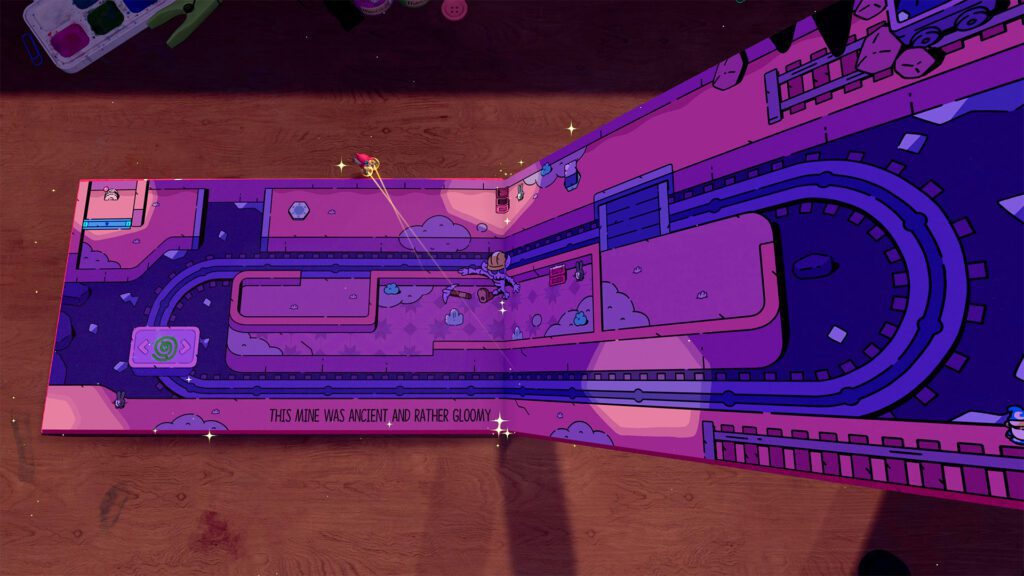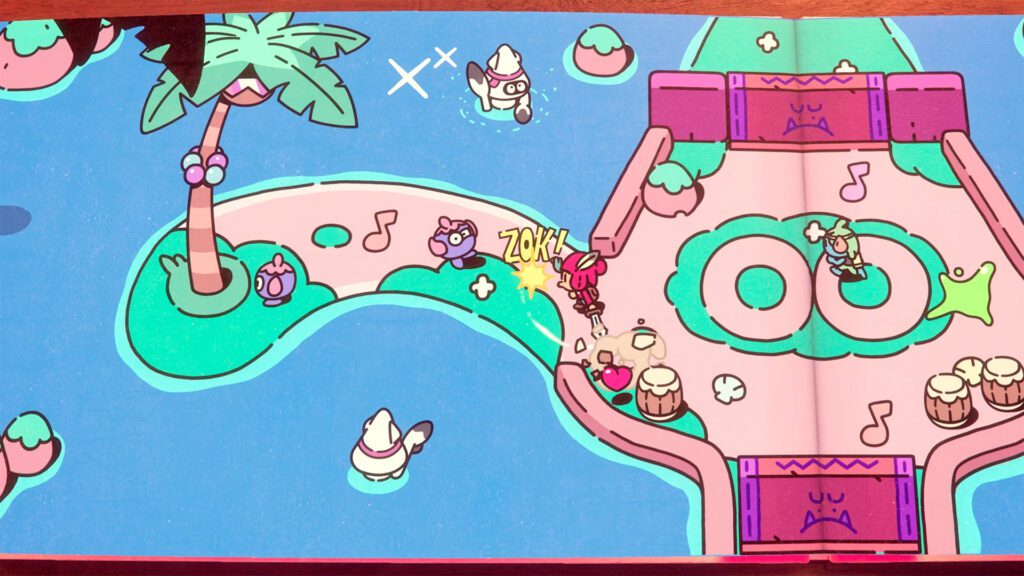Nintendo’s The Legend of Zelda series is often credited as revolutionizing top-down action-adventure games. This is evident by the influence the franchise has had on the genre. Examples include indie darling Tunic and the upcoming Mina the Hollower. The impact Zelda’s gameplay has had on the industry is proof Nintendo struck gold in 1986. Indie newcomer All Possible Futures’ first title The Plucky Squire is an inventive take reminiscent of game’s past while offering a fresh and exciting experience from start to finish.
A “Meta” Quest
“The Plucky Squire” is a fictional children’s book within the game’s world. These books star Jot, an adventurer and writer known as “The Plucky Squire” himself. One day, the nefarious sorcerer Humgrump discovers “The Plucky Squire” series of books, revealing that he is merely an antagonist within a line of storybooks. Humgrump’s self-awareness results in him discovering metamagic; a powerful magic capable of bending the fabric of reality. Using his newfound ability, Humgrump banishes Jot from his book and into the real world. With the help of many allies, Jot must alternate between the pages of his book and the desk of a 10-year-old child to save his home world of Mojo.
A Story Within A Story
The majority of The Plucky Squire takes place within the pages of a book located on Sam’s desk. While the world within the book has a 2D art style, the book itself is a 3D-rendered object sitting on a desk. This results in a surreal perspective, immediately implying the world within and outside of the pages. The concept of multiple living worlds housed within a child’s bedroom is very Toy Story-esk and shares a similar charm. The contrast between the two art styles works well not only in the context of the story but from a visual perspective.
 Actively Audible
Actively Audible
Throughout The Plucky Squire’s ten chapters, Jot’s journey has narration. This adds immersion to the fact that the game takes place within a book while also adding depth to the overall audio design. While not every page has narration, the ones that do use it expertly as a way to progress the story or transition to different environments. The soundtrack played throughout is serviceable. There is nothing advertinly wrong with any of the music. It is unfortunate that the songs fail to leave a lasting impression. The tracks do fit the mood and don’t feel out of place; however, they’re just easily forgettable and uninspired.
Storybook Heavy
While in the two-dimensional Land of Mojo, Jot navigates from a top-down perspective. These sections are visually storybook-themed, complete with thick outlines and vibrant colors. Area transitions are a turn of the page, another reminder of the fictionalized setting. Many new pages will start with dialog, which fits the storybook theme. That said, it’s a bit disjointing when the goal of going from specific pages is to take out all the enemies. Some of the dialog seems unnecessary and distracts rather than adds to the depth.
Combat Made Simple
The Plucky Squire features somewhat simplified combat, which allows for movement, swordplay, and jumping. With his trusty sword, Jot can cut grass, activate environmental switches, and take out Humgrump’s henchmen. Lightbulbs can be found scattered around the environment and awarded for defeating enemies. While initially starting Jot will only be able to slash his sword, eventually, he can upgrade his abilities by cashing in his collected lightbulbs. These upgrades include additional sword-based abilities, as well as strength boosts. None of these upgrades felt essential, meaning the game can be completed without upgrading for an additional challenge.
 Fourth Wall Fun
Fourth Wall Fun
Many elements within The Plucky Squire will require the usage of breaking the Fourth wall, That imaginary wall separating the life within the book and the world outside of it. Many puzzles within the storybook pages will require paying attention to the book’s text. Placing different words in the text of the story will fundamentally change the reality of the book. For example, there is an area early on where the text “The _ Swung _” leaves Jot to discover the words “Gate” and “Open” scattered about. When placed onto the text, now reading “The Gate Swung Open,” Jot can proceed through the opened gate.
Think Outside The Book
One of the most creative aspects of The Plucky Squire is its transitions from 2D to 3D. When Jot is transported into the real world, he takes on a three-dimensional rendered toy-like form, complete with a glossy, shiny texture. Outside of his book, Jot is faced with not only the typical Humgrump baddies but also live insects. While the combat element of gameplay remains intact, these sections play out more like a 3D platformer. Jot’s jump ability shines as he platforms across obstacles scattered around Sam’s desk and surrounding shelves. These segments also incorporate his ability to transmute to and from two-dimensional planes, resulting in unique puzzles and interesting pathways. The 3D gameplay is where The Plucky Squire perhaps shines the brightest. It is rather unfortunate that these areas only take up approximately a quarter of the game.
 Collect Them All
Collect Them All
Along Jot’s adventure, he will come across mysterious Glitchbirds. These mysterious creatures are visually akin to Breath of The Wild’s Korok Seeds, albeit with a fruit-shaped head. Lost and looking for their way home, these little beasts are cleverly hidden. Another hidden discovery within the world is art scrolls. When collected, these reveal key artwork, drawings, sketches, and concept artwork from The Plucky Squire’s early stages. This gallery allows a small glimpse into the game’s developmental process.
Minigame Madness
At its core, The Plucky Squire is an action-adventure game. That said, there are quite a few minigames that feature drastically different playstyles. These minigames range from 2D platforming sections inspired by SEGA classics, Shoot ‘em up style horizontal shooters, bubble popping puzzles, rhythm-based action and espionage, and more. These additions allow for a fun and well-designed change of pace between the main game. If any of the minigames prove to be too challenging, they can be skipped within the pause menu. These minigame challenges only make up a small portion of the game, leaving the desire for more.
 Closing Thoughts
Closing Thoughts
The Plucky Squire is an incredibly inventive and unique amalgamation of 2D and 3D gameplay. Its charming little story is played out with a comedic tone and sarcastic humor that is a welcomed accompaniment to the incredibly fun-to-play gameplay. There were times it felt like Earthbound and others Zelda; however, The Plucky Squire was able to form an identity of its own through its glowing personality. While a tad on the easy side, The Plucky Squire is an artful and entertaining story worth exploring.
The Plucky Squire is available now digitally on Nintendo Switch, PlayStation 5, Steam, and Xbox Series. Physical versions are available for preorder on Amazon via Devolver Digital.
A Steam code for The Plucky Squire was provided for the purpose of review.





